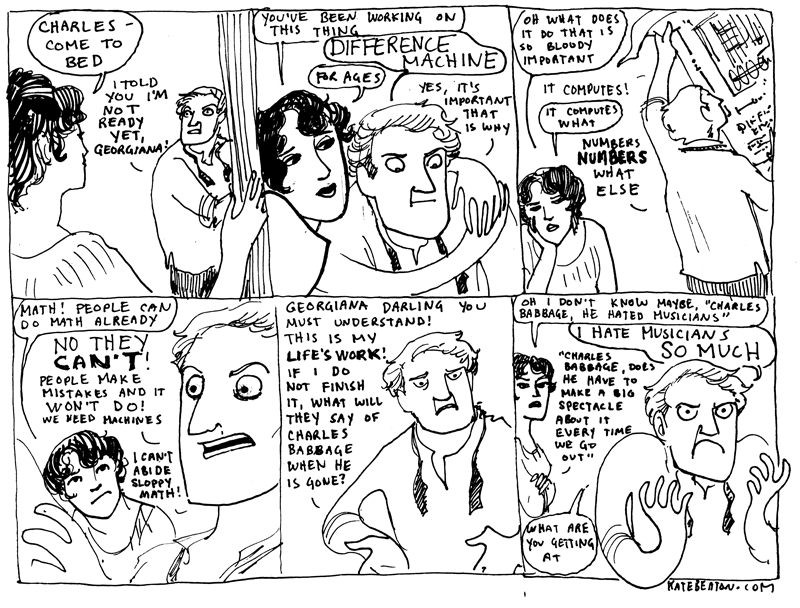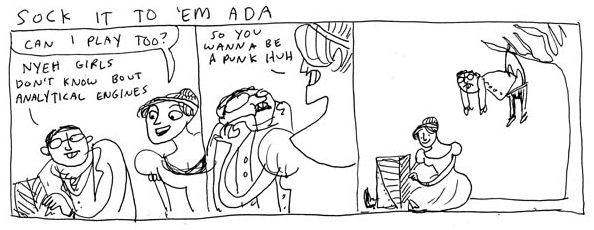PLANT: Why Freud Gets the BS Award (and I Do Not Mean Bachelor of Science)
I LOVED Plant’s essay, “Ada Lovelace and the Loom of Life.” It was short, stock-full of information, and offered a compelling and engaging argument by going into the details of the history of weaving. As Plant explains, that very history has very much been rendered insignificant, probably because of its association with women’s work and commoners’ work. Plant’s essay reveals, however, that this women’s work has been of utmost importance in looking at multimedia, technology, and story-telling. Using weaving as an analogy for programming is intriguing and, I think, quite a legitimate way of tying technology, industry, and women’s history together.
Even the humorous publishing House, McSweeney’s, sees the relation between programming and sewing: St. James Parish Sewing Club Members Whose First Names Sound Like Programming Languages.
What’s more, the exploration of Ada Lovelace’s biography was a joy to read since she’s basically one of my heroes. Plant effectively places her in a scientific/technological timeline that often displaces or ignores the role of women (since “history,” as Haraway has pointed out, is traditionally a discourse dominated by white, middle-class men). I know I’ve posted this before, but I’m reposting because the Kate Beaton’s comics are too wonderful to keep to myself:
(http://www.harkavagrant.com/index.php?id=141)
An English Major Gets on Her Soapbox:
Since I come from a literary background, I thought I’d add a little to Plant’s essay in terms of the history of weaving. In literature, at least, women are often depicted or described as engaged in this business, but it is fascinating to note the ways in which weaving resists dismissal as insignificant or inartistic. Penelope in the Odyssey weaves and unweaves as a means of stalling the impetuous suitors in her home, revealing the way in which weaving serves as not only an artistic act, but also a political act. She is negotiating the politics of widowhood and courtship through her weaving, using it as means of prolonging her wait for Odysseus.
In A Tale of Two Cities, Madame Defarge continuously knits, secretly encoding the names of those she wants killed into her weaving. Notice in this instance the way in which weaving is distinctly communicative, truly a medium for passing information. The seeming banality of knitting a garment is undermined by the fateful coding occurring in the act. Like the thread of the fates, her knitting can bring life or death. It’s not just a pretty little scarf.
Jennifer Munroe argues that Renaissance poet Lady Mary Wroth (niece of Mary Sidney and Sir Philip Sidney) used needlework imagery in her poems, particularly in Pamphilia to Amphilanthus, as an analogy to and reflection of women’s writing. (N.B. Munroe’s essay can be found here, and also in an issue of Tulsa Studies in Women’s Literature.) Through her poetry, she relates sewing to authorship, a comparison that has a long history in women’s writing, up to modern novelists in fact. Text becomes indistinguishable from textile, and writing is neatly compared to sewing and/or weaving. Munroe also explains that women’s needlework was actually used in female economy as a means of exchange; that is, it was a currency medium, revealing the way in which sewing and weaving takes on a variety of meanings and encodes information in different ways.
As seen in these examples, which represent very few in a long history of literature involving women sewing or weaving, weaving and sewing are at once political, artistic, economic, technological, and communicative. As Plant states, “Weaving has always been a multimedia event” (258). Programming, in a way, is just another kind of weaving, perhaps more on the “text” end than the “textile” end, but related nonetheless. Plant effectively reveals its importance and the importance of women in this process.
HARAWAY: Congratulations! You’re Posthuman, and Your Boyfriend’s a Cyborg!
Okay, so I’ve gushed enough about sewing, Ada, and Plant. On to the other authors! Since I’ve started out of order, I might as well continue in that direction and address Haraway’s piece briefly:
I’ll be frank: Donna Haraway’s piece confused me an irritated me, because she seems to have a penchant for issuing a series of bold and cryptic statements without always grounding them in specific examples. For all she has to say about discourses and breaking down all these boundaries, her piece seems quite caught up in a postmodern, intellectual discourse that confounds me. I do find value in her piece, however, in her points on the changing image of humanity in, as Hayles would put it, a posthuman world. The cyborg is breaking down the traditional liberal-humanist boundaries that Hayles was talking about, the historical humanist discourse dominated by white, middle-class, males.
To Haraway, it seems the cyborg offers a freeing up of this biased humanist “unity” in favor of fragmentation, affinities (as opposed to unities), and equality. If we can blur the boundaries between the “real” and “unreal,” or the “human” and the “machine,” or even the “human” and the “animal,” then we most certainly can question the boundaries of the “male” and “female,” the “black” and “white,” etc. What’s more, disembodiment (a point Haraway makes that reflects Hayles again) because of a cyborg future can further disinherit these traditional binary discourses that are based on oppositions. If there is no body, or the body is insignificant, than what significance is there in inscribing the meanings “male” or “female” onto a body (I’m thinking of the feminist critic Judith Butler here). These signifiers break down when the signified–the body–loses its unity and importance.
TURKLE: The Turkle Down Effect – How Virtuality Pervades Reality
Sherry Turkle’s 1995 piece seems dated in some regards, but her ultimate questions and worries are quite relevant in today’s virtual climate. Ultimately I see Turkle’s piece as a questioning of reality. What makes reality real, and can we call virtual reality “real” in any way? Is the violation of a virtual body the same as the violation of a “real” body? This, to me, was perhaps the most intriguing question in her work, particularly when she discusses virtual rape on the MUDs. Whether or not the violation is equivalent, I have to say that virtual rape still presents a significant social problem because it represents the reinforcement of the cultural attitudes that promote rape in the first place. In my current sociology class, we read a piece by Diana Scully and Joseph Marolla on convicted rapists, and the piece basically demonstrates the way in which rape is not in fact some psychological abnormality but is a social issue and, based upon cultural norms, is not necessarily abnormal. Scully and Marolla hold that rape reflects the pervading cultural attitudes toward women–the widely practiced and held notion of the subjugation of women. The “cure” to the prevalence of rape, then, is not necessarily psychological therapy but cultural “therapy.” Virtual rape merely reinforces the attitude that sexual violence toward women is rewarding and/or not truly harmful and/or a person’s right.
I think, even with this in mind, however, that many of us would still see a significant difference between virtuality and reality, particularly in MUDs. Losses in MUDs do not have nearly the same impact as losses in reality. Notice, however, how this boundary is crossed as real-business dealings and social dealings are conducted online, in virtual space. Finances are almost completely electronic now; a loss of money in an online bank account is the same as a very real loss of material wealth. Now, the loss of a Facebook friend often is the same as actually losing that friend in reality. Look at the way break-ups are sometimes conducted: by removing the Facebook status “in a relationship” and changing it to “single.” This process, fortunately, is still seen as an underhanded way to break it off with someone, but it still constitutes a very real breakup in an relationship–not just the breakup between two virtual personas.
Turkle notes the way virtual environments were starting to be used in the work setting; we see this now in every major company. I work at Hewlett-Packard over the summers, and have noticed that most employees (particularly contracters) prefer to work at home and phone in or Skype in to meet with people. Why be in a confining cubicle, when you can be just as present to your coworkers in the comfort of your own home? I often work from home for HP, and communicate to my coworkers and employers through a constant chat window in the corner of my screen or through email. HP now has these wicked awesome HALO rooms (no, not for the video game)–conference rooms that allow people from all over the world to appear on screens in the room and see the whole room at large. In these rooms, meetings are conducted the same way as if everyone were physically there, because those virtually present can see everyone in the room with the same perspective as if they were sitting there. In this case, reality and virtuality intersect to create an optimal meeting experience.
Bowing-Out with Babbage
I think I’ve provided quite enough food for thought here, so I’ll call it a night. I truly enjoyed this week’s readings, especially the connections between technology, virtuality, and feminism. I’ll leave you with a last comic about Charles Babbage, who had a well known dislike of street musicians:
 http://www.harkavagrant.com/index.php?id=5
http://www.harkavagrant.com/index.php?id=5
Pip pip cheerio!



I found your analysis of weaving in literature to be quite interesting. I’ve read both The Odyssey and A Tale of Two Cities, but I’d forgotten about the instances of weaving until you mentioned them. I’m especially intrigued by the idea that programming is a type of weaving. There are so many connections that can be drawn between the two. The foundation for weaving is of utmost importance. If the first strings aren’t placed correctly, the entire work will unravel. Likewise, the basis for programming code is extremely important. One small error will cause your program to crash.
I found your insights about the growth of losses in the virtual world to be extremely interesting. I hadn’t really realized how much more we are impacted by things as small as our status as friends or relationship status.
Ms McAuliffe, I just have to say: your posts this semester have generally been some of the most innovative in our class, but this week you took it to a whole different level. Outstanding.